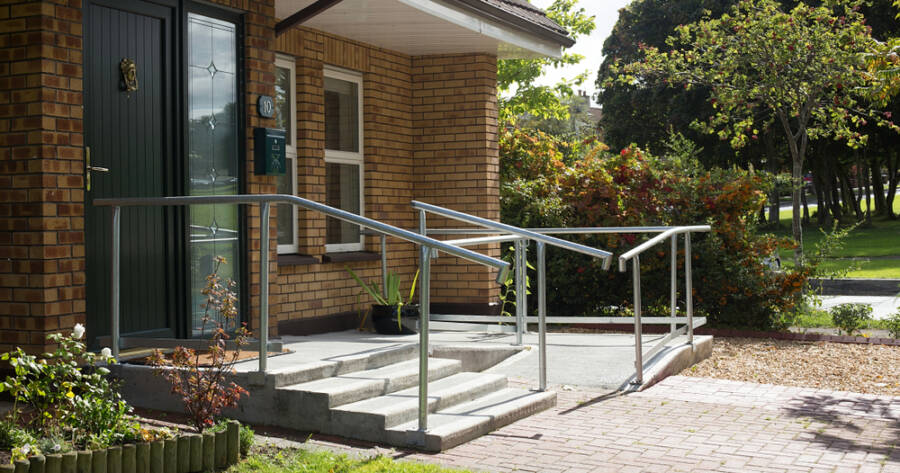As people age, their needs for a safe and accessible living environment often change. For seniors, maintaining independence while ensuring safety and comfort at home is a top priority. Making the necessary modifications to a home can significantly improve mobility and reduce the risk of falls or other accidents. From simple changes to more extensive renovations, accessible modifications are an essential aspect of aging in place, allowing seniors to live comfortably and securely in their own homes for as long as possible. Explore some key accessible modifications that can help make a home safer and more functional for seniors.
1. Ramp Installation for Easy Access
One of the most common and important modifications for seniors is the installation of ramps. As mobility becomes more difficult, stairs can present a major obstacle. Ramps provide an easy solution for navigating the entryways of the home, especially for those using wheelchairs, walkers, or scooters. Installing a ramp at the main entrance can significantly enhance accessibility, allowing seniors to move freely in and out of the home without assistance.
In addition to the front entrance, consider ramps for other areas such as porches, patios, and garages, if applicable. Ramps should be constructed with proper incline and grip to ensure safety and ease of use.
2. Grab Bars and Handrails for Support
Installing grab bars and handrails in key areas of the home is one of the most cost-effective modifications to enhance safety. These support bars help seniors maintain balance and stability, especially in high-risk areas such as bathrooms and stairways.
Bathroom: Grab bars should be installed near the toilet, in the shower, and around the bathtub. Adding a handrail to the side of the bathtub or shower can also provide additional support for seniors while bathing. Non-slip mats or adhesive strips should be added to prevent slipping.
Stairs: Installing handrails on both sides of the stairs ensures that seniors can maintain their balance while going up or down. These rails should be sturdy and easy to grip for maximum safety.
3. Widening Doorways for Mobility Aids
For seniors who use wheelchairs, walkers, or scooters, having wide doorways can be critical for maintaining independence. Narrow doorways may hinder mobility, forcing seniors to rely on assistance to get around the home. Widening doorways allows for easy access to different rooms and eliminates barriers that might limit movement.
This modification may require adjustments to the door frame and may be more extensive in older homes. However, widening doorways provides a significant improvement in terms of both mobility and safety for seniors.
4. Lever-Style Door Handles and Faucets
For seniors with limited hand strength or dexterity, traditional round door knobs and faucets can be challenging to use. Replacing these with lever-style handles provides a simple but highly effective modification. Lever handles require less effort to turn and are easier to grip, making it easier for seniors to open doors or control faucets.
This modification is inexpensive and easy to install, but it can make a big difference in promoting independence and reducing the frustration of struggling with everyday tasks.
5. Improving Lighting for Better Visibility
As vision often diminishes with age, improving lighting around the home is a vital modification for seniors. Proper lighting helps reduce the risk of trips and falls and makes it easier for seniors to navigate the home safely, especially in hallways, stairways, and bathrooms.
Consider installing brighter lights in key areas and adding motion-sensor lights to hallways and bathrooms. This ensures that lights automatically turn on when needed, helping seniors avoid accidents during the night. Additionally, using contrast colors on floors, walls, and furniture can enhance visibility and depth perception, which may help seniors with vision impairments.
6. Non-Slip Flooring
Falls are one of the leading causes of injury for seniors, and many of these falls occur due to slippery floors. Non-slip flooring is a crucial modification to reduce this risk. Materials such as rubber, cork, or textured vinyl provide better traction and are ideal for high-risk areas like kitchens and bathrooms.
For existing floors, you can also use non-slip rugs or mats to prevent slipping, especially in areas where water or moisture is present. Make sure that rugs are securely fastened to the floor to avoid tripping hazards.
7. Smart Home Technology
Integrating smart home technology can make a big difference in the daily lives of seniors. Devices such as voice-controlled assistants (like Amazon Alexa or Google Home) can help seniors control lights, locks, and thermostats without needing to physically move around. Smart doorbell systems allow seniors to see who is at the door without having to open it, and automated systems for monitoring health or sending emergency alerts provide an added layer of safety.
Smartphones and apps designed for seniors can also assist with reminders for medication, appointments, and other important tasks, helping seniors stay organized and on top of their daily routines.
Enhancing Senior Living with Accessible Home Modifications
Making accessible modifications to a home is one of the most important steps in ensuring that seniors can live safely, comfortably, and independently as they age. Whether it’s installing ramps, adding grab bars, widening doorways, or improving lighting, these modifications can significantly improve mobility, reduce the risk of accidents, and enhance the quality of life for seniors. Aging in place is an empowering option for many seniors, and with the right adjustments, they can continue to enjoy their homes with the security and independence they deserve. These modifications may require an upfront investment, but the long-term benefits of safety, comfort, and convenience make them well worth it.

